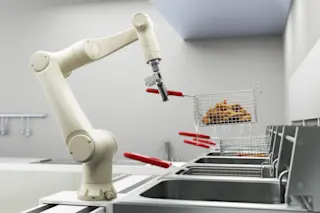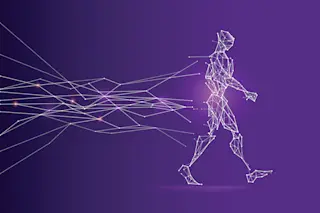On the quarter-mile walk between his office at the École Polytechnique Fédérale de Lausanne in Switzerland and the nerve center of his research across campus, Henry Markram gets a brisk reminder of the rapidly narrowing gap between human and machine. At one point he passes a museumlike display filled with the relics of old supercomputers, a memorial to their technological limitations. At the end of his trip he confronts his IBM Blue Gene/P—shiny, black, and sloped on one side like a sports car. That new supercomputer is the centerpiece of the Blue Brain Project, tasked with simulating every aspect of the workings of a living brain.
Markram, the 47-year-old founder and codirector of the Brain Mind Institute at the EPFL, is the project’s leader and cheerleader. A South African neuroscientist, he received his doctorate from the Weizmann Institute of Science in Israel and studied as a Fulbright Scholar at the National Institutes of Health. For the past 15 years he and his team have been collecting data on the neocortex, the part of the brain that lets us think, speak, and remember. The plan is to use the data from these studies to create a comprehensive, three-dimensional simulation of a mammalian brain. Such a digital re-creation that matches all the behaviors and structures of a biological brain would provide an unprecedented opportunity to study the fundamental nature of cognition and of disorders such as depression and schizophrenia.
Until recently there was no computer powerful enough to take all our knowledge of the brain and apply it to a model. Blue Gene has changed that. It contains four monolithic, refrigerator-size machines, each of which processes data at a peak speed of 56 teraflops (teraflops being one trillion floating-point operations per second). At $2 million per rack, this Blue Gene is not cheap, but it is affordable enough to give Markram a shot with this ambitious project. Each of Blue Gene’s more than 16,000 processors is used to simulate approximately one thousand virtual neurons. By getting the neurons to interact with one another, Markram’s team makes the computer operate like a brain. In its trial runs Markram’s Blue Gene has emulated just a single neocortical column in a two-week-old rat. But in principle, the simulated brain will continue to get more and more powerful as it attempts to rival the one in its creator’s head. “We’ve reached the end of phase one, which for us is the proof of concept,” Markram says. “We can, I think, categorically say that it is possible to build a model of the brain.” In fact, he insists that a fully functioning model of a human brain can be built within a decade. Markram spent some time with DISCOVER to explain how.
Most people—even most scientists—still regard the brain’s inner workings as a mystery. Yet you believe not only that you can understand the brain but that you can, in effect, re-create it. What do you see that others do not? Everybody agrees that the brain is a remarkable machine. It’s capable of generating an enormous number of phenomena, some of them very obvious and some of them less obvious. But I think that in the end there are going to be some very basic explanations for many things: emotions, awareness, consciousness, attention, perception, recognition. We have to address a couple of fundamental problems, but I see them as problems only because we are stuck in two old paradigms of thought.
What are the outmoded paradigms that we need to get past? The first is related to how the brain represents information, what I call an action-potential paradigm. It’s a spike-based paradigm. Neurons generate spikes of activity. You can think of these spikes as digital: zeros and ones. Individual spikes do not have enough information to represent perceptions. The current view of perception is based on analyzing these zeros and ones and trying to decompose or reverse engineer the representation that these zeros and ones capture. But I think that the zeros and ones—the information generated or emitted by single neurons—are a reflection of perception, not perception itself.
A lot of people study these single spikes. What we have been working on with Blue Brain is like a Copernican revolution, because we want to flip things around and say that neural representation does not lie in the spikes. It lies in the branches beyond, before it gets to the cell body. When this new way of thinking starts to take hold, I think it will open up a lot of doors into what perception is—and from perception what recognition is, and from recognition what memory is, and then higher functions, such as awareness or emotions.
What is the other big misconception that’s holding us back? For 50 years we’ve been thinking of memory, despite all evidence to the contrary, as where you imprint changes in the brain. You go to your synapses, you go to your neurons, and you change them when you remember something. And then you’ve got to protect those changes. It’s an imprint. It’s called an engram. Hundreds of scientists have been chasing this engram. Where is the print of memory in the brain? They think it’s like a scar, a mark. This is one of the most fundamental mistakes in neuroscience. And the reason why I say it’s a mistake is simple. All evidence indicates that the neuron does not reset. The synapses do not reset. They are always different. They’re changing every millisecond. Your brain today is very, very different from what it was when you were 10 years old, and yet you may have profound memories from when you were 10. What has to be answered in neuroscience is this: How do you remember something from long ago when your brain now is actually different?
We have had too many physicists move into neuroscience and say, “Oh, it must be some kind of statistical distributed memory, so even if it’s overwritten there will still be some traces of it.” In our view, the idea that memory is held in the brain the same way it is held in a computer is fundamentally wrong.
So those are the two paradigms that we’re stuck in. I think that cracking them is going to change a lot of things about the mystery of the brain.
How can a simulation crack the mystery of the brain? Don’t you need to understand it before you can simulate it?
To understand how a protein behaves in the context of a whole brain, you’re going to need to put it into a whole brain. You’re going to need to play with it, change its parameters, take it out, put it in, make a mutation. We need the flexibility to be able to explore thousands, hundreds of thousands, millions of parameters. A model is one way to do it—but not the kind of model that people have been using. I’m talking about real, biologically constrained models. The most serious misconception about Blue Brain is that people think we’re doing a modeling project. Actually Blue Brain is very much about reverse engineering, looking at all the data, standardizing the data, getting the information into a framework where we can even do correlation-based science on it, building automatic tools to synthesize those data into biological phenomena. I think of the process as virtualizing life, virtualizing the brain.
How do you even approach such a huge and radical project? Before we did this, it was a three-year Ph.D. project to simulate even one neuron. And you needed an entire, very powerful computer to run that simulation of one neuron. You needed the whole process. Of course, today computers are a little more powerful, and I can run a simulation of 100 neurons. But there’s really no point in doing a 100-neuron simulation. The reason is simple: A neuron lives in an environment. It receives thousands of inputs. So actually you need to make a quantum leap from one neuron to 10,000 neurons. You need to make that leap into what we call a microcircuit. A circuit of five neurons is not what the mammalian brain is made up of. To simulate the neurocircuitry that is creating the mammalian brain, you need to make a quantum jump in complexity. You need at least 10,000 computers to do that. And that’s what Blue Gene is—16,000 processors squeezed into a space the size of four refrigerators. It was important for us to have that many processors, because on each one we’ve got 1,000 neurons. The processors themselves did not have to be extremely powerful. They just needed enough memory to hold the neurons.
You are modeling not a human brain or a monkey brain but something very specific—the neocortical column in a two-week-old rat. Why that particular set of neurons? Blue Brain is a bio-driven project, meaning that we work to capture the biological elements, processes, and principles as mathematical models, and then run simulations to see how they mimic biology. We are trying to re-create biology in software as accurately as possible. I was not prepared to sacrifice a lot of cats or primates—this research requires dissecting brains and comparing the simulation to the real thing—so we had to choose either mice or rats. Then it was a question of which brain region to focus on. Even though the neocortex is the most advanced region, it’s got more order and organization and therefore actually is more tractable. If you go into the brain stem or into other subcortical areas of the brain, the neurons have no distinguishing features. They’re all kinds of shapes. A two-week-old animal is ideal, actually, because at that stage slices of the brain preserve extremely well for 24 to 48 hours. The circuit at that age is going to be in 75 to 80 percent of the final state it will be in during the adult stage. What it gives us is the template for brain circuitry. Once we have the template we look for variations, and then we can model development. We can now model younger columns, and we can model older columns. When we find out the key differences between species, we will be able to start simulating and modeling evolution, too.
Your experiment has been going on for more than four years now. What have you learned so far about the neural processes in the brain? One very interesting property that emerged is a rhythm of electrical activity called gamma oscillations. It appeared one week when we added in the step of biological simulation. We did not try to build it in—it just showed up. Gamma oscillations are the basis for consciousness, according to a famous theory. The theory holds that when the brain goes into high-frequency (40- to 80-hertz) oscillations, those oscillations do perceptual binding, which is the foundation of consciousness. I don’t think that Blue Brain is conscious at this point, though.
It’s significant that we didn’t specifically try to model the phenomenon in the brain. All we have to do is pay attention to the fact that we are building it correctly, and these phenomena emerge. The whole circuit goes into this resonant state, which is an amazing state. Now we can dissect the circuit and find out exactly which neurons were crucial, which pathways, which receptors, and so forth.
As we’ve taken steps closer to the biology, the circuit has started to display more and more of the actual biological phenomena that we find in experiments, with more and more precision and accuracy and elegance. This is very encouraging because the model could have gone in any other direction. It could have just not worked. As you put in more and more fine-tuned parameters, it might start doing all kinds of things you would not want or expect it to do.
Can you also use Blue Brain to help with medical problems—to study the nature of neurological diseases? Actually, this is the only way to study them. When you turn on this column and you run it, you think, my God, there’s not a single neurological disease today in which anybody knows what is malfunctioning in this circuit—which pathway, which synapse, which neuron, which receptor. Doctors don’t even know this for a single drug—I mean, this is a multibillion-dollar industry!—that they’re giving for Parkinson’s disease, for depression, schizophrenia, attention deficit, autism, dementia, Alzheimer’s. When they give a drug, they have no idea what it does to this processor. And the neocortical column is the elementary processor for human beings to have coherent perception, attention, and memory. This is shocking. I mean, we are living in such a primitive time of medicine, you cannot imagine.
How could your work fill in the missing understanding?If you have the model where you’re able to embody all the key parameters, you can start exploring a hypothesis for a disease. When you tweak the model, you can see what kind of pathology occurs. You’ll be able to really isolate very precisely what has gone wrong. If a certain part of the circuit malfunctions, it’s going to display certain symptoms. You can actually simulate and test hypotheses for different diseases. If we know which pathways are malfunctioning, then we can look and see what it means for the circuit, what kind of information is it not able to process. This can guide drug discovery by letting you simulate the effect of a drug on the circuit. You’re going to find out exactly how it operates, what it is altering. Drug discovery is terribly expensive, just to find out how one drug could or could not work and all its side effects. Simulations could cut drug discovery costs by 70 or 80 percent. What we call in-silica-based drug discovery—simulation-based drug discovery—is going to be the future.
How soon could simulated brains lead to new drugs for treating our real brains?We’re already at prototype stage. We can already start on a limited scale. But I think this is coming within the next two or three years. As the model gets more powerful, its reach will spread to more and more domains of neurology and psychiatry.
What are the next great milestones for the Blue Brain project? In particular, when will you be able to simulate a human brain, not just a section of rat brain?It’s a question of scaling, and it’s a question of resolution. The next phase is going to be a massive expansion toward whole-brain models, and also toward very detailed molecular-level models. Technologically, in terms of computers and techniques to acquire data, it will be possible to build a model of the human brain within 10 years. Practically, the only limitation is funding. But we are taking this step by step. The next step should take us in three years to a whole-brain model of a rat and a detailed molecular-level model of the interactions of the 200 million neurons in a rat’s brain. That’s going to provide most of the key stepping-stones to be able to do the next jump to cat, primate, and human brain models, which will happen pretty much in parallel.
One of the most important things we have realized in this project is that you don’t need to know 100 percent of how the biology works. Because after you put in the data for 5 percent or 10 percent, it starts constraining almost everything else. Which means you can actually learn the rest without knowing what it was before, so in the end it just gets faster. As you add more constraints, it’s like an acceleration. My prediction is that we will understand the brain, its design and function, way before we finish building it.
If it really is mainly a matter of money to build a full simulation of the human brain, how much money would it take?A lot. More than the Human Genome Project, much more. There are the supercomputers that are required. And you need the researchers, because it’s not only us, it’s a consortium that is going to have to grow enormously. The computers alone would cost hundreds of millions of dollars, maybe even a billion dollars. Then you need the data that describe the brain’s composition and structure—such as the number of proteins in the brain, what kind they are, how they interact, the density of cells. The data need to come much more from industry, not just from science labs. We need to get industrial-scale data, and actually that’s going to be an enormous cost.
What then? Once we model the human brain, will we be able to experience and re-create what goes on in a person’s mind?It’s not really very complicated. In order for me to read your thoughts, I need to be able to look at your patterns, and I need to be able to convert them into a readout. I have to be able to translate that activity. That is the neural code. I need to understand it and to read it, decode it.
As we become better at decoding the neural information, I think that will not be such a big deal. If we can extract information, it’s more of a technological limitation. Can you extract it? Can you get enough sampling? Can you measure the activity state? The technology for doing these things is improving a lot. We are very close to the neural code. All indications are that it will improve a lot in the next couple of years.
Will we be able to simulate consciousness at that point? Or the even more staggering question—will the simulation actually be conscious at that point?It’s really difficult to say how much detail is needed for consciousness to emerge. I do believe that consciousness is an emergent phenomenon. It’s like a shift from a liquid to a gas. It’s a property. It’s a new phase. It’s like a machine that has to run fast enough and suddenly it’s flying. That’s what, in this project, we’ll be able to perhaps find out—how much detail is needed for the machine to really take off and become conscious.
Some people have said that you are playing God. Do you ever feel that way? As scientists we need to not be afraid of the truth. We need to understand our brain. It’s natural that people would think that the brain is sacred, that we shouldn’t tamper with it because it may be where the secrets of the soul are. But I think, quite honestly, that if the planet understood how the brain functions we would resolve conflicts everywhere. Because people would understand how trivial and how deterministic and how controlled conflicts and reactions and misunderstandings are. Where did these behaviors come from? The answer is understandable and tractable and traceable. We shouldn’t die for certain things that may well just be because of a chemical firing off in one part of the brain.
I think that understanding the brain is going to be an enormously great awakening. It could well be a crucial thing for humanity. I think that we’re far from playing God. God created the whole universe. We’re just trying to build a little model.














